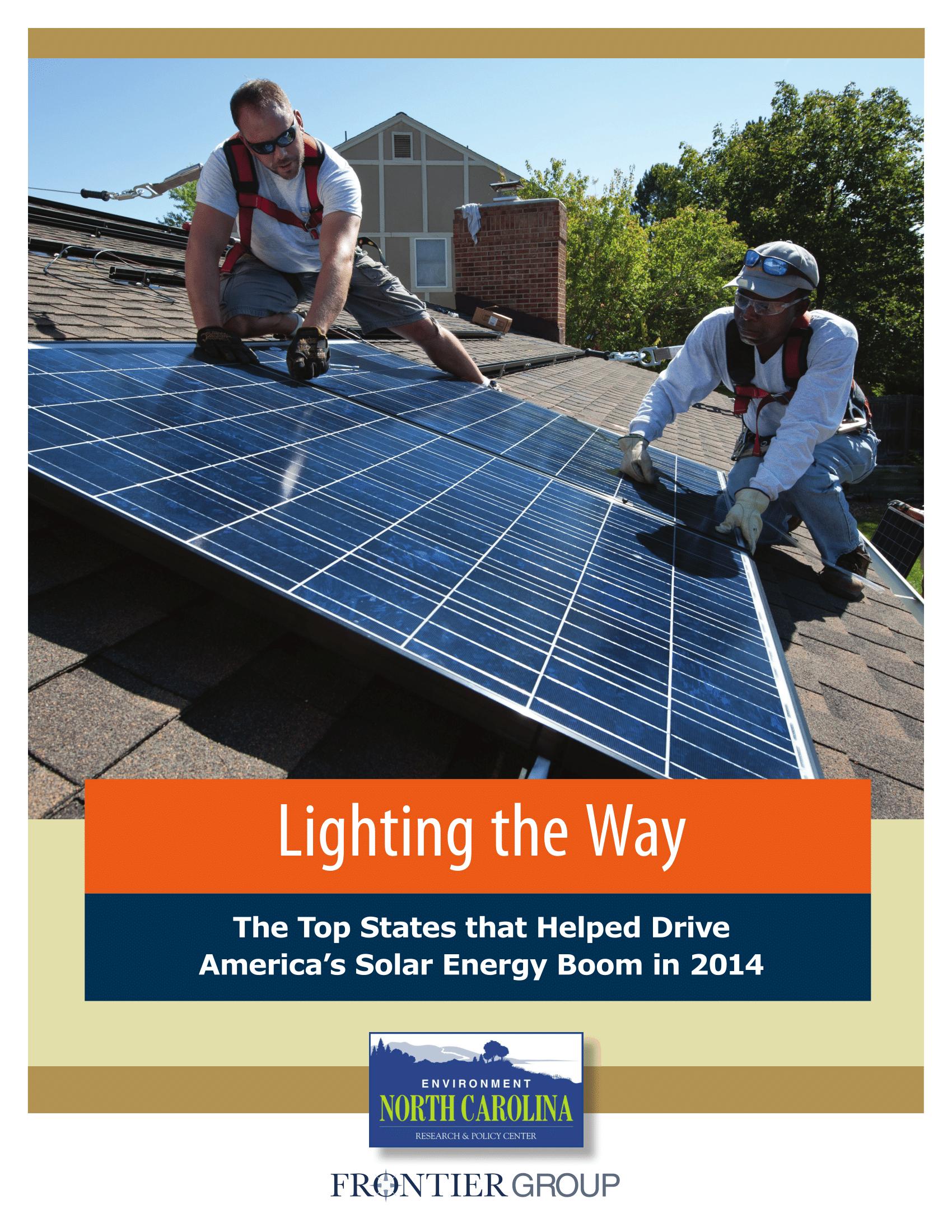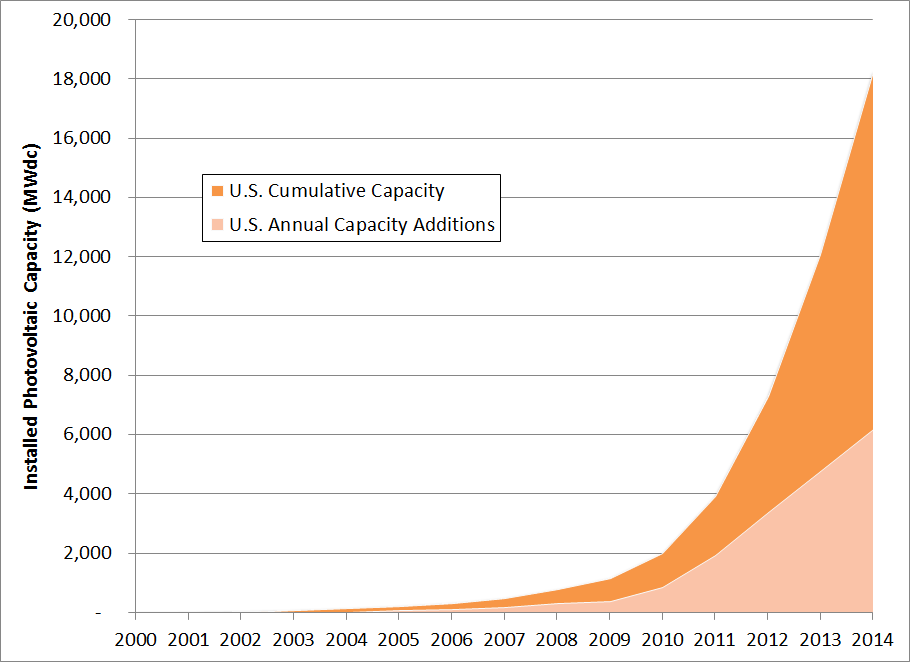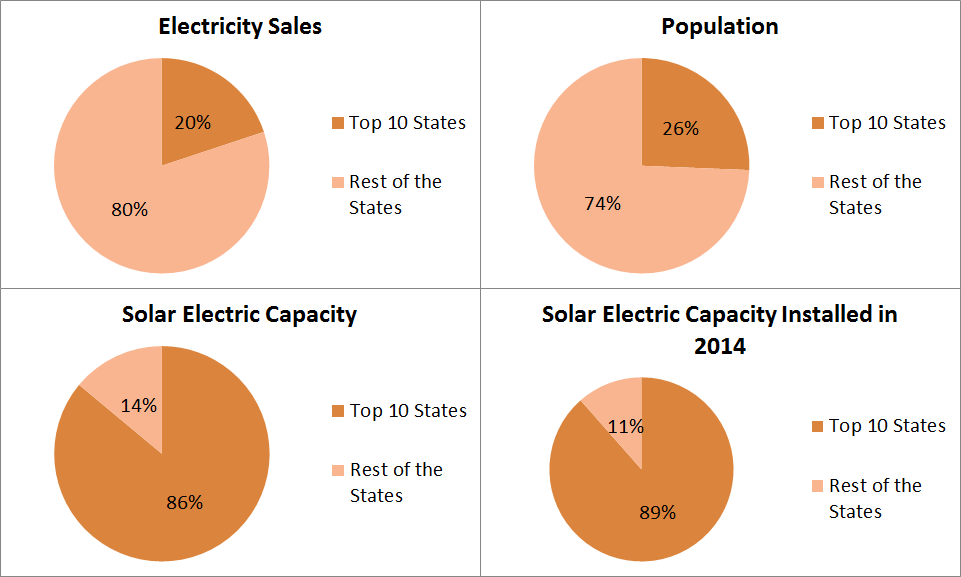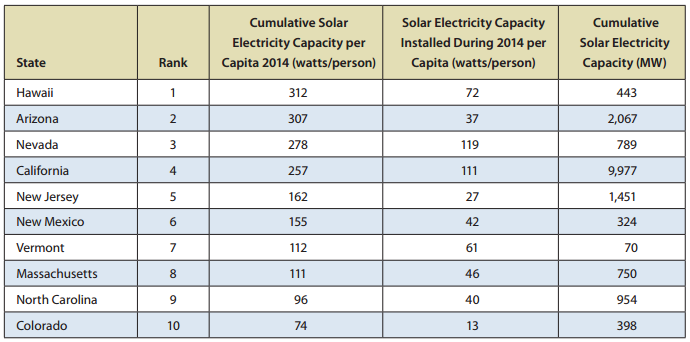Lighting the Way
The Top States that Helped Drive America’s Solar Energy Boom in 2014
Solar energy is booming. In just the last three years, America’s solar photovoltaic capacity tripled. In 2014, a third of the United States’ new installed electric capacity came from solar power. And in three states – California, Hawaii, and Arizona– solar power now generates more than 5 percent of total electricity consumption.

Downloads
Executive Summary
Solar energy is booming. In just the last three years, America’s solar photovoltaic capacity tripled. In 2014, a third of the United States’ new installed electric capacity came from solar power. And in three states – California, Hawaii, and Arizona – solar power now generates more than 5 percent of total electricity consumption.
With the cost of solar energy declining rapidly, tens of thousands more Americans each year are experiencing the benefits of clean energy from the sun, including energy generated right on the rooftops of their homes or places of business.
America’s solar energy revolution continues to be led by a small group of states that have the greatest amount of solar energy capacity installed per capita. These 10 states have opened the door for solar energy and are reaping the rewards as a result.
The Top 10 states with the most solar electricity installed per capita account for only 26 percent of the U.S. population but 86 percent of the nation’s total installed solar electricity capacity.* These 10 states – Arizona, California, Colorado, Hawaii, Massachusetts, Nevada, New Jersey, New Mexico, North Carolina, and Vermont – possess strong policies that are enabling increasing numbers of homeowners, businesses, communities and utilities to “go solar.”
Figure ES-1. Cumulative U.S. Grid-Connected Solar Photovoltaic Capacity

The continued success of solar power in these and other states has been threatened, however, by recent attacks by fossil fuel interests and electric utilities on key solar policies, such as net metering. Despite those attacks, many states have reaffirmed and expanded their commitments to solar energy over the past year by increasing solar energy goals and implementing new policies to expand access to clean solar power.
By following the lead of these states, the United States can work toward getting at least 10 percent of our energy from the sun by 2030, resulting in cleaner air, more local jobs and reduced emissions of pollutants that cause global warming.
Solar energy is on the rise – especially in states that have adopted strong public policies to encourage solar power. In 2014:
- Hawaii surpassed Arizona to become the state with the most cumulative solar capacity per capita. In 2015, Hawaii signaled its intention to continue its solar energy leadership by passing America’s first 100 percent renewable electricity standard.
- Nevada and California added the most solar capacity per capita. Nevada’s solar growth reflects a booming solar industry, with more solar jobs per capita than any other state, while California added more total solar capacity in 2014 than all other states combined.
- Arizona slipped from first in 2013 to eighth in 2014 for installations of new solar energy capacity per capita, as new fees levied on solar customers in much of the state dampened demand for solar energy.
- Vermont joined the Top 10 after 100 percent of its new electric generating capacity in 2014 came from solar energy.
- New York and Texas are among the Top 10 states for total solar energy capacity, though not for capacity per capita. New York has seen dramatic solar energy growth as a result of strong policy support from state leaders. Texas has benefited from local solar energy policies in cities such as Austin and San Antonio, despite poor policy support at the state level.
Figure ES-2. Solar Energy in the Top 10 Solar States versus the Rest of the U.S.

Table ES-1. Solar Electricity Capacity in the Top 10 Solar States (ranked by cumulative capacity per resident; data from the Solar Energy Industries Association)

America’s leading solar states have adopted strong policies to encourage homeowners and businesses to “go solar.” Among the Top 10 states:
- Nine have strong net metering policies. In nearly all of the leading states, consumers are compensated at the full retail rate for the excess electricity they supply to the grid.
- Nine have strong statewide interconnection policies. Good interconnection policies reduce the time and hassle required for individuals and companies to connect solar energy systems to the grid.
- All have renewable electricity standards that set minimum requirements for the share of a utility’s electricity that must come from renewable sources, and eight of them have “carve-outs” that set specific targets for solar or other forms of clean, distributed electricity.
- Nine allow for creative financing options such as third-party power purchase agreements, and nine allow Property Assessed Clean Energy (PACE) financing.
- States in the Top 10 are far more likely to have each of these key solar policies in place than other states, reinforcing the conclusion of U.S. Department of Energy research linking the presence of key solar policies to increases in solar energy deployment.
- Within three days of each other in June 2015, two Top 10 states passed the strongest renewable electricity standards in the country: Hawaii passed the nation’s first 100 percent renewable electricity standard, and Vermont passed a 75 percent renewable electricity standard with the nation’s strongest solar carve-out.
Strong public policies at every level of government can help unlock America’s potential for clean solar energy, while helping states comply with the Environmental Protection Agency’s Clean Power Plan. To achieve America’s full solar potential:
- Local governments should implement financing programs such as property-assessed clean energy (PACE) and on-bill financing, adopt bulk purchasing programs for solar installations, and adopt solar-friendly zoning and permitting rules to make it easier and cheaper for residents and businesses to “go solar.” Local governments should also pass solar access ordinances to ensure homeowners’ right to generate electricity from the sunlight that hits their property. Municipally owned utilities should promote solar energy through rate design (including rate structures that have a higher ratio of per-kilowatt-hour to per-customer charges), by providing net metering or fair value-of-solar rates, and through investments in community-scale and utility-scale solar projects.
- State governments should set ambitious goals for solar energy and adopt policies – including those described in this report – to meet them. State governments should also use their role as the primary regulators of electric utilities to encourage utility investments in solar energy, implement rate structures that maximize the benefits of solar energy to consumers, and support smart investments to move toward a more intelligent electric grid in which distributed sources of energy such as solar power play a larger role. Finally, state governments should adopt policies guaranteeing homeowners and businesses the right to use or sell power from the sunlight that strikes their properties, and should allow third party ownership agreements.
- The federal government should continue key tax credits for solar energy, encourage responsible development of prime solar resources on public lands in the American West, and support research, development and deployment efforts designed to reduce the cost of solar energy and smooth the incorporation of large amounts of solar energy into the electric grid.
All levels of government should lead by example by installing solar energy technologies on all government buildings where it is feasible to do so.
*In this report, “solar photovoltaic capacity” refers to installed solar photovoltaic systems, both distributed and utility-scale. “Solar electricity capacity” refers to all solar technologies that generate electricity, including concentrating solar power systems that use the sun’s heat – rather than its light – to generate electricity. The figures in this report do not include other solar energy technologies, such as solar water heating.

